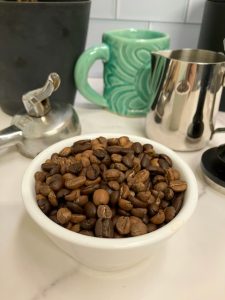Last time we learned about what happens to the coffee when it gets roasted. Today we’re looking at how different flavors come out of different roasts.
Light Roasts
Through the Maillard Reaction, as coffee beans are exposed to heat, they will start to brown, and their amino acids break down and reform to have a slightly sweeter taste. We typically pull light roasts from the roaster after first crack starts but before it finishes. They are higher acidity and less bitter than darker roasts. Light roasts allow for more delicate flavors to be present in the cup, like floral notes. Additionally, they typically have a lighter body. Because light roasts have had less exposure to heat, they are best for retaining the uniqueness of a particular region and varietal. Check out BCR’s light roasts here.
Medium Roasts
Medium Roast are the mainstay of specialty coffee. We learned last time that after first crack, the beans go into the development stage. Medium roasts are those pulled from the roaster at any point in the development stage. The longer exposure to heat gives medium roasts more sweetness than light roasts, and also tempers down the acidity. Also, medium roasts have a little more bitterness and more body. They are a great balance between showcasing the coffee’s uniqueness and the roaster’s skill. You can find our medium roasts here.
Dark Roasts
After the development stage, the beans enter second crack. We typically pull dark roasts from the roaster in the middle of second crack. They are more bitter, and have very low acidity. Dark roasts tend to lose the sweetness that medium roasts have. Generally, dark roasts have less variation, so less of the uniqueness of each bean comes out in the cup. They also tend to have a fuller body and longer aftertaste. Pick up our Game Day Dark here!
Something we love about coffee is the wide range of flavors the same coffee can have depending on its roast. It motivates us to keep learning and trying new things with our coffee.

